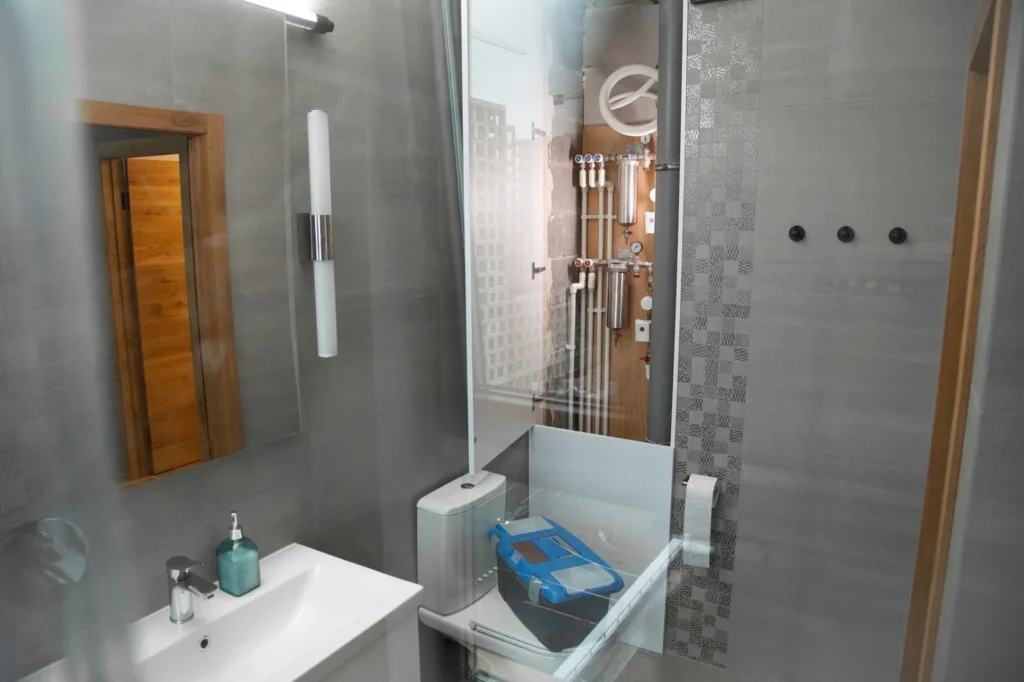If you’re working with a small bathroom, you know how tricky it can be to create a space that’s both functional and stylish. Wet rooms, with their open, streamlined design, are becoming a popular choice for smaller bathrooms, offering a smart solution for making the most of every inch. Let’s explore how wet rooms can transform small spaces—from maximising layout to clever storage and choosing the right materials.
Maximising Space with a Wet Room Layout
Open-Plan Design
The beauty of a wet room lies in its simplicity—there are no walls separating the shower from the rest of the bathroom. This openness makes the space feel larger than it actually is, as it allows the eye to flow freely through the room. By using an open-plan design, you’re not just making the most of the space visually, but also creating a sense of freedom and movement in an otherwise cramped area. Check out Plumbworld if you’re interested in wet room shower solutions.
Optimising the Layout
When working with a small bathroom, every inch of space matters. The key is to position fixtures efficiently to create a functional layout. Consider placing your shower in a corner or along the back wall to maximise available space. You can even create a clever flow by positioning the toilet or basin along the opposite wall, keeping the room open and spacious while still being practical.
Flow and Accessibility
A well-designed wet room offers both practicality and comfort. The open layout enhances the flow of the room, making it easier to move around. Since there are no raised edges or bulky shower doors, accessibility is improved, particularly for those with limited mobility. A smooth, level floor means no obstacles, creating a safer and more comfortable experience.
Clever Storage Solutions for Wet Rooms
Built-in Shelving and Nooks
Storage in a small wet room doesn’t have to be a challenge. To save space and avoid clutter, opt for built-in shelving or hidden nooks. Wall-mounted shelves are a great way to store toiletries without taking up floor space, keeping the room neat and tidy. You can even integrate a shower niche into the walls to hold shower products, leaving the space feeling more streamlined.
Wall-Mounted Fixtures
When it comes to storage, wall-mounted fixtures like towel racks, mirrors, and storage cabinets are your best friends. These types of installations keep the floor clear, which is crucial in a small bathroom. They also help create the illusion of more space by allowing you to store items off the floor and keep everything within arm’s reach.
Hidden Storage
Hidden storage is a fantastic way to make a small bathroom feel more spacious. Consider incorporating storage solutions like under-floor compartments or cabinets behind mirrors. These clever touches not only save space but also maintain a sleek, minimalist aesthetic in your wet room.
Choosing the Right Materials for a Compact Wet Room
Light Colours and Reflective Surfaces
One of the easiest ways to make a small wet room feel larger is by using light colours and reflective surfaces. Choose pale tiles, light wood, or white fixtures to create a sense of openness and brightness. Reflective surfaces, such as glossy tiles, mirrors, or glass from GCS Glass & Mirror Austin TX, will bounce light around the room, making it feel airy and expansive.
Non-Cluttered Design
In a small wet room, less is more. Opt for simple, clean materials that don’t overwhelm the space. Choose large, uniform tiles to create a sense of continuity throughout the room. A minimalist design will help keep the space feeling open and calm, without distractions or clutter.
Durable, Waterproof Materials
Wet rooms are constantly exposed to moisture, so it’s essential to use materials that are not only stylish but also durable and waterproof. Consider materials like porcelain or ceramic tiles for the walls and floor. Acrylic panels and waterproof paints are also great options for wet rooms as they’re easy to clean and resistant to water damage.
Is It Easier to Clean a Wet Room?
If you’ve never had a wet room before, you might be on the fence about creating one. In particular, you may be concerned that there’s more cleaning involved. Yes, there can be a bigger area that you clean, and you might have to do this more consistently. However, the advantage is that your bathroom becomes easier and faster to clean. Let’s take a look at why this is the case.
It Is Open Plan
When you have an enclosure shower, there are so many places where germs and dirt can hide. This means corners you can’t reach and awkward places you can’t get with a normal cloth. Thankfully, the same doesn’t apply to a wet room. Since it has an open plan design, this makes it quicker and faster to clean. In fact, many people say that their bathroom is more hygienic because of this design.
It Is Waterproof
Something that you have to be careful of in a bathroom is water damage. For example, floors can often be somewhere that’s affected first. Then, when things get damaged by water, it’s easy for mould and mildew to grow. The great thing about a wet room is that the materials tend to be waterproof. This makes it safer and easier to clean your bathroom. You don’t have to worry about how wet it’s getting.
Better Drainage
Drainage is important when you’re cleaning your bathroom. Again, you don’t want mould or mildew to have an environment to grow. With a wet room, drainage is imperative. It’s going to be better and make sure that water doesn’t pool. Moisture shouldn’t be a problem, which makes cleaning simple.
Conclusion
A wet room is a fantastic way to make the most of a small bathroom, combining style, functionality, and space-saving design. From maximising space with an open-plan layout to choosing the right fixtures and materials, there are plenty of ways to optimise your wet room for small spaces. Whether you’re renovating your current bathroom or designing a new one, a wet room can help you create a modern, spacious, and highly functional bathroom, no matter the size of your space.







